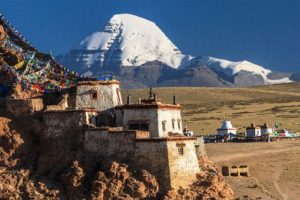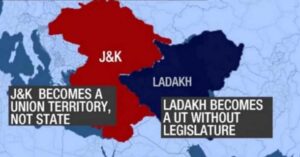Even as the removal of Kashmir’s special status by the Narendra Modi -led central government has drawn mixed reactions from the Indian public, the consequences of the move to split the disputed state into two Union Territories could have massive repercussions for the Tibetan population living in Ladakh.
On August 5, amidst a sharp scaling up of army presence in the valley, Bharatiya Janata Party (BJP) leader, Amit Shah, announced the immediate abrogation of section 370, which has awarded ‘special status’ to Kashmir since 1947. He also said that article 35A, which granted the people of Kashmir a different set of laws and rights, including, amongst others,those related to the ownership of land, citizenship and other fundamental rights, would be scrapped, and the population brought under the same set of laws as the rest of India . The third major announcement was that the state would now be split into two Union Territories (UT), to be governed directly by the central government – Jammu and Kashmir UT would have legislature, whilst Ladakh UT would not.
This change for Ladakh, the sparsely populated desert-like region on the western side of Jammu and Kashmir, which has a large Buddhist and Tibetan population, has not gone down well with China. A part of Ladakh bordered by Tibet called the Aksai-Chin region has been administered by China since 1962.
Whilst the Buddhist-majority enclave has largely lauded the government’s move in the hope that the change that could spur economic and infrastructure development and increase tourism in Ladakh, China has condemned India’s decision as a direct threat to its influence in the contested Western Himalaya. In a statement issued last week, Beijing described the move as “unacceptable.” It also showed its resentment by denying visas to a group of devotees from India planning to make a pilgrimage to the Kailash Mansarovar peak which lies in China -occupied Tibet.
Chinese Foreign Ministry spokes woman,Hua Chunying, said that Beijing disputed the inclusion of what it claims as Chinese territory on the Indian side of 3,500-kilometer Himalayan border. “India’s unilateral amendment to its domestic law continues to damage China’s territorial sovereignty. This is unacceptable” said Hua. As well as China, the move has also rattled Pakistan, which has now severed all diplomatic ties with India. With Pakistan Prime minister Imran Khan calling the BJP-led central government in India ‘fascist’ and comparing them to Nazis, the neighbouring country has also stopped all trade with India. The Indian ambassador in Islamabad has been expelled, and Pakistan has also withdrawn its envoy to India.
While the BJP MP in Ladakh has welcomed the move, the people of Ladakh are uncertain as to whether it would make things worse.
Jamyang Tsering Namgyal, the newly elected young BJP MP from Ladakh said, “Ladakh, for too long, had been given a step-motherly treatment by the Kashmir-centric state government in terms of funding, job opportunities and employment” and called the decision a “harbinger of development.”
 Whilst the people of Ladakh have demanded Union Territory status for their homeland for several decades now, a large population of the mountainous region is somewhat thrown by the central government’s recent move, as it has come with a worrying clause: namely, the UT of Ladakh will have no legislature, which translates to having no representation in the centre, meaning the central government gets to take unilateral decisions on matters pertaining to the people of the new UT.
Whilst the people of Ladakh have demanded Union Territory status for their homeland for several decades now, a large population of the mountainous region is somewhat thrown by the central government’s recent move, as it has come with a worrying clause: namely, the UT of Ladakh will have no legislature, which translates to having no representation in the centre, meaning the central government gets to take unilateral decisions on matters pertaining to the people of the new UT.
In the scrapping of Article 370, Ladakh loses the protective provisions granted under Article 35A that gets ditched as a subordinate article. This enabled the state to define ‘permanent residents’ and protected certain rights, crucial ones being employment under the state and theacquisition of immovable property. This move lifts the ban on non-residents purchasing land, causing concern that it would invite non-residents to settle in Ladakh and negatively affect the Ladakhi way of life as well as its fragile ecosystem, already reeling under pressure fromthe tourist footfall. It could also drive up the land value, and make buying a home or commercial property inaccessible to local people. Whilst the majority of the Ladakhi population is Muslim, Tibetan-origin Buddhists form over 40% of the demographic.
The second concern voiced by the residents of Ladakh is the possibility of ecological destruction of the picturesque destination. As social studies student Shumzin Stobdan puts it in her blog for the eco website ‘Delhi Greens’, “How much development is good for the region is up to the people of Ladakh to decide. Ladakh is need to be more responsible with their land and resources, as infinite development is not viable when resources are finite. Ladakh is already facing an acute water crisis and plastic pollution, and much of the blame goes to rapid infrastructure development, mass tourism and climate change. The situation will only worsen with time.” Echoing the worries of many young people on the plateau, Stobdan continues, “It is thus necessary for the people of Ladakh to become aware of the threats of unplanned development and move towards sustainable and inclusive development that benefits the locals and does not threaten the environment and culture. Indeed, shifting both existing and forthcoming tourist initiatives towards sustainable and ecotourism is the need of the hour in the new Ladakh.”
The major changes brought into these regions by Modi government witnessed applause as well as criticism and what future holds for them, only time will tell.







 Print
Print Email
Email